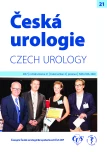Laparoscopic nerve sparing extraperitoneal radical prostatectomy – video
Authors:
Milan Hora 1; Petr Stránský 1; Tomáš Ürge 1; Olga Dolejšová 1; Hana Svobodová 1; Jiří Ferda 2; Ondřej Hes 3
Authors‘ workplace:
Urologická klinika, LF UK a FN Plzeň
1; Klinika zobrazovacích metod, LF UK a FN Plzeň
2; Šiklův ústav patologie, LF UK a FN Plzeň
3
Published in:
Ces Urol 2017; 21(4): 268-271
Category:
Video
Overview
Introduction:
The most advantageous approach for radical prostatectomy has not been yet been proven based on evidence-based medicine. Great emphasis is placed on the erudition of the surgeon, whatever technique is used. However, there is a clear shift from open to miniinvasive technology. If the robotic system is available then it is preferred. Workplaces not equipped with this system must choose between open or laparoscopic approach. In our work we present our approach to laparoscopy.
Material:
748 laparoscopic radical prostatectomies (LRP) were performed between 8/2008 and 10/2017. Preoperative S-PSA was 10.17 ± 6.47 (0.72–55.42) μg / L and PHI (at 548) 63.38 ± 31.91 (13.02–292.74). Preoperatively examined with MRI 534 (71.4%), choline PET CT 13 (1.7%) and choline PET MRI 53 (7.1%) of men. 48 (6.4%) were selected for transperitoneal surgery (mostly in obese with concurrent lymph node dissection – LND), for the remaining extraperitoneal. LND was performed in 180 (24.1%). Nerve sparing surgery was done bilaterally in 180 (24.1%) and unilaterally 93 (12.4%). The procedure was performed by 4 surgeons. The methodology of the operation was of course slightly modified over the years (various sealing tools, types of clips and sewing materials and changing the operating system from 2D to 3D). The current surgical procedure of the extraperitoneal nerve-sparing approach is shown in video: A surgeon and two assistants. In the Trendelenburg position, the operating space prevesically is created by a forefinger through a short subumbilical incision, 4 ports (2 x 5 mm, 2x 10 mm) are inserted blindly under finger control, the videoport introduced through subumbilical incision. The endopelvic fascia is opened on both sides and the Santorini plexus is sutured with a V-Loc 90® stitch. The bladder‘s neck is separated from the prostate with a harmonic scalpel. Ducti deferenti are interrupted and seminal vesicles are released by clip or fine bipolar coagulation. On the sides, the prostate is separated by nerve-sparing technique with Hem-O-Lok® L and M-size clips and titanium clips of size M. The Santorini plexus and urethra are interrupted by scissors. The specimen is extracted into the Endocatch® Gold bag through subumbilical incision, which is then partially sutured again. Using the V‑Loc 90® running suture, the dorsal urethrovesical plate is created with two revolutions, then the anastomosis of the bladder neck with the urethra. In the broad bladder neck, this is closed at the end ventral longitudinally. The water resistance of the anastomosis is verified by bladder filling with 150 ml. Antibiotic prophylaxis is not used. Long-term miniheparinisation only in LND. Drain is removed after disappearance of secretion and urinary catheter mostly on 12th postoperative day.
Results:
Average chosen parameters: age 64.7 ± 5.9 (41.7–81.8) years, operation time without LND 123.9 ± 33.4 (62–240) min, with LND 169.7 ± 31.4 (100–265) min, blood loss 498.7 ± 324.6 (30–4000) ml, BMI 29.4 ± 3.7 (20.2–40.0), weight of prostate specimen 57.8 ± 24.0 (20–262) g. Conversion to open surgery in 24x (3.2%). Positive margins in 36.7%. The assessment by colouring ink and wholemount section techniques. A more detailed analysis of results is beyond the scope of the video presentation.
Conclusion:
Laparoscopic radical prostatectomy at our hospital completely replaced the open approach and makes up for the missing robotic system. It allows takinge advantage of all the benefits of a mini-invasive approach with known limits over robotic performance. Performance is standardized and is only suitable for experienced surgeons.
Key words:
Prostate cancer, radical prostatectomy, laparoscopy.
Sources
1. Jarolím L, Kawaciuk I, Hanek P, et al. Functional results of radical retropubic prostatectomies. Ces Urol 2005; 9(1): 20–25.
2. Doležel J, Tvarůžek J, Staník M, et al. Our early experience with robotic‑assisted laparoscopic radical prostatectomy – first 153 cases. Ces Urol 2009; 13(2): 168–177.
3. Broďák M, Košina J, Balík M, et al. The first experience with unilateral barbed suture V‑Loc in laparoscopic radical prostatectomy. Ces Urol 2012; 16(3): 157-162.
4. Broďák M, Košina J, Hušek P, et al. A comparison of laparoscopic and retropubic radical prostatectomy – a single center experience. Ces Urol 2012; 16(4): 222–229.
5. Novák K, Macek P, Vraný M, et al. Endoscopic extraperitoneal radical prostatectomy and its complications – personal experience from the first 300 procedures. Ces Urol 2014; 18(2): 119–127.
6. Pivovarčíková K, Branžovský J, Bauleth K, et al. Radical prostatectomy – analysis of 191 cases examined using whole‑mount section method. Ces Urol 2014; 18(1):26–32.
7. Morávek P, Broďák M, Košina J, et al. The complications following radical prostatectomy via open or laparoscopic approach, a comparison of results according to the Clavien system scale. Ces Urol 2015; 19(1): 56–63.
8. Jarolím L, Veselý Š, Schmidt M, et al. Follow‑up and treatment of patients following radical prostatectomy with positive surgical margins. Ces Urol 2017; 21(2): 139–146.
Labels
Paediatric urologist Nephrology UrologyArticle was published in
Czech Urology

2017 Issue 4
Most read in this issue
- Experience with the prostate health index in daily clinical practice
- Agranulocytosis after analgesic treatment for renal colic
- Home‑based sperm analysis with a smartphone? Welcome to the age of telespermatology
- Assoc. Prof. Miloš Broďák, M.D., Ph.D., celebrates his anniversary
